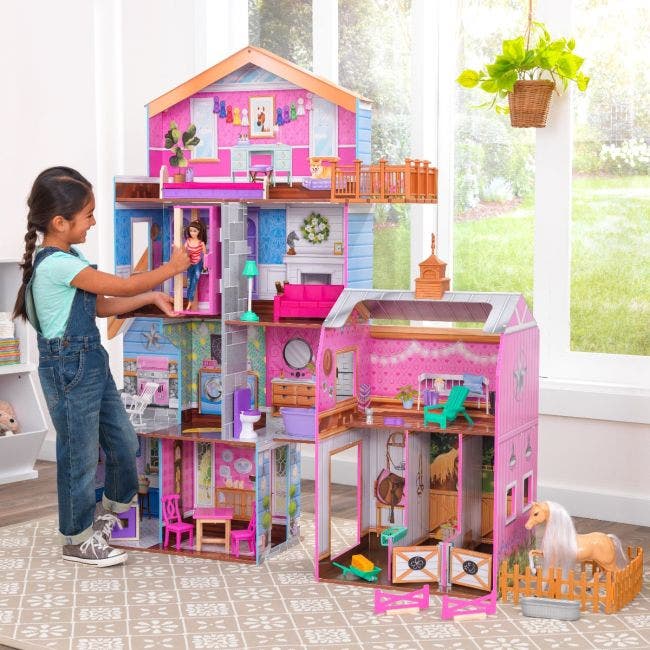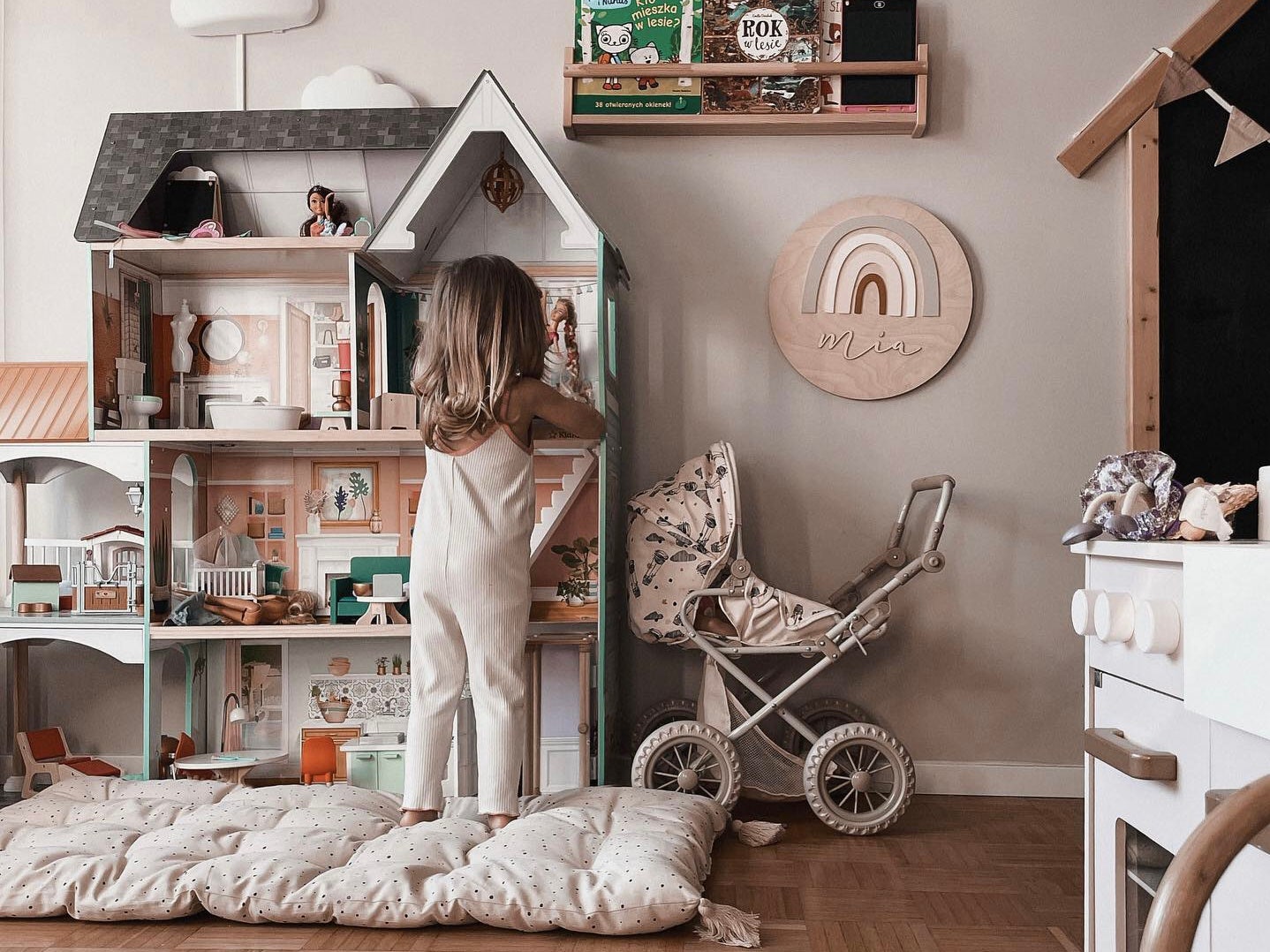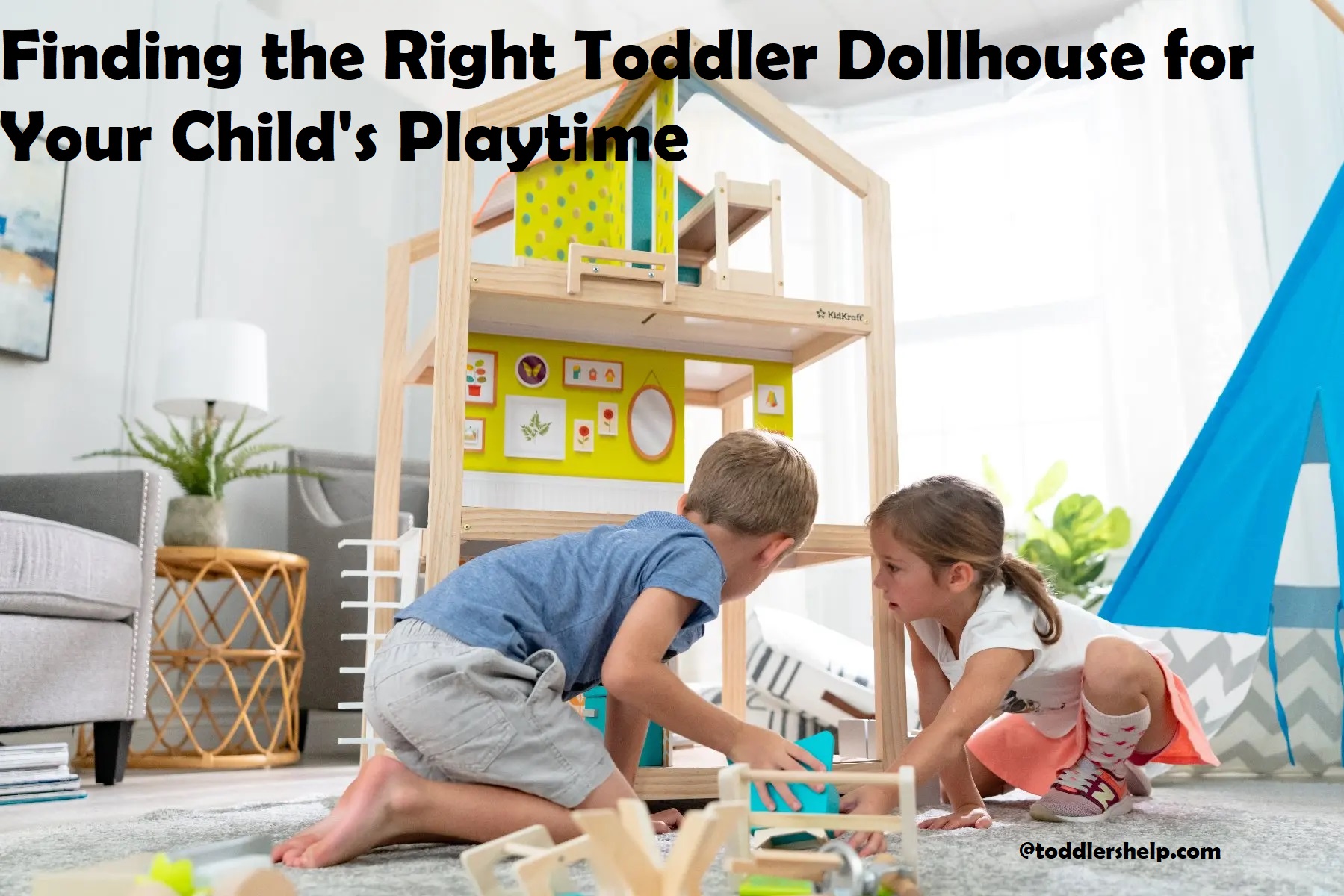Are you looking for the perfect toddler dollhouse to make your young one’s playtime enjoyable? You’re in luck!
This article provides a complete guide to finding the right dollhouse for your toddler. With this guide, you can make an informed decision and provide a memorable playtime experience for your child!
When it comes to finding the perfect toddler dollhouse for your child, there are several things you should consider. It’s important to think about the age range, size of the house, materials used in construction, and your budget. And with so many options out on the market today, it can be hard to make a decision.
That’s why we’ve created this guide – to help take some of the guesswork out of shopping for a dollhouse. Whether you’re looking for a simple play set or something more elaborate and feature-rich, we’ll show you what features make up a good toy and also provide suggestions on some of our favorite products currently available.
We hope this guide provides all of the information you need to choose the right toddler dollhouse for your child and their playtime. Ready to get started? Let’s dive into what makes a good toy house!
Importance of dollhouses in child’s playtime
Dollhouses are more than just playtime fun – they are highly beneficial to the emotional and mental health of toddlers. Playing with dollhouse dolls helps children practice nurturing through soft, safe pretend scenarios. Dollhouses provide countless opportunities for learning about colors, shapes and sizes, as well as gender roles within a family or larger community context.
Careful consideration should be given before purchasing a dollhouse for your child’s playtime in order to ensure that the toy will lead to maximum benefits from hours of imaginative play.
Overview of the guide
This guide will provide an overview of the various toddler dollhouses available on the market today so that parents can make an informed decision to ensure their child plays with a safe and stimulating toy.
The guide will take a look at different types and styles of dollhouses, as well as discussing the key features to look for in order to ensure your child gets the right toy. It will also analyze the safety factors of each type, considering materials and construction, although it is always important that parents check over any toy before giving it to their children.
Finally, we’ll review some of the most popular toddler dollhouses out there and give our expert buying advice.
Considerations before buying a toddler dollhouse
It is important to consider a few key factors before deciding on the perfect dollhouse for your toddler. The scale of the structure should match that of your child’s favorite dolls or action figures; purchasing a house too small to accommodate them will only lead to disappointment. Additionally, think about the durability of the dollhouse material –– Wooden structures are generally sturdier than cardboard or plastic models, which may have difficulty standing up over time.
Be aware that many children demand an excess of accessories with their playhouses. Depending on your budget, it might make sense to invest in a more expensive model with detailed features and extras such as furniture, figures, and small items – these can be fun additions that add new layers of fun during playtime.
Finally, it is important to consider safety factors as there may be risk concerning cutting edges/corners and objects which may choke young children if left unattended. Taking these concerns into account before making a purchase will ensure that you purchase the most appropriate dollhouse for your toddler’s safe and enjoyable playtime environment.
Age-appropriateness
When shopping for a toddler dollhouse, age-appropriateness is key. A dollhouse should be suited to the age and interests of your child. Generally, toddlers between age 2 and 5 are most engaged by dollhouses.
For younger children (2-3 years), look for a plastic dollhouse that encourages hands-on exploration with objects they can pick up, move around and stack. They may also be fascinated by doors that open and close and windows that let in light.
For older toddlers (3-5 years), look for a wooden dollhouse with sturdy furniture that can withstand playing with dolls or action figures. Your child will appreciate realism in the design of the house, complex play scenarios and accessories that invite imaginative play like photo frames or tiny dishes to set up a pretend mealtime.
Consider getting creative accessories your child can make their own like small pieces of felt to create their own curtains or quilts for their dolls’ beds. You may even find models that have separate areas for transporting mini figures in miniature cars or other moving objects: perfect for older children looking to explore various storylines through pretend play.
Size and space
When considering a dollhouse for your toddler, size and space are two key factors. Choose one that won’t take up too much room but is still big enough for them to play with easily. Smaller size houses may work better for younger tots and larger sizes can accommodate more dolls and activities. Look for houses that come with furniture pieces such as a kitchen set or bedroom set so your toddler can immediately get playing.
Also consider the open areas or windows that let light in so your toddler can peek inside the house and explore its contents. Dollhouses should also be lightweight, easy to pick up, and durable enough to withstand hours of fun playtime.
Materials and durability
The material used in the construction of any dollhouse is an important consideration when buying. Wooden dollhouses are the most traditional option, often built with real wood, plywood, particle board, or plastic composite materials. They come pre-painted or unassembled, often requiring assembly and painting after purchase. Because they are constructed with real wood they tend to be a bit more durable and can be customized further; however they tend to be heavier, take up more space, and may contain small pieces making them better suited for an older child.
Plastic dollhouses are a lighter more affordable option that comes pre-painted in vibrant colors. They also tend to break down into smaller pieces for convenient storage when not in use but offer less customization options than wooden models. Choose a plastic house that has rounded edges so no one will get scratched accidentally while playing and avoid options with small parts as these could pose a choking hazard for those under 3 years of age.
Moreover, the furniture pieces themselves come in various materials such as plastic or wooden versions for durability; however some may have small parts so again check carefully before purchase to ensure safety standards are met for your child’s age group.
lll. Maintaining and cleaning the toddler dollhouse
Maintaining a child’s toy should be done on a regular basis, not just when the toy appears to be dirty. Keeping a toddler dollhouse clean helps keep it looking like new and helps preserve the materials used to make it. The easiest way to keep these types of toys clean is by wiping them down with a damp cloth and mild soap solution.
It is also important to make sure to examine the toy upon completion of cleaning; this makes sure no parts have become loose or broken while cleaning. Additionally, this allows for any necessary repairs that need to be done in order for the toy to remain safe and enjoyable.
For non-wooden dollhouses, they can usually be wiped down with a wet cloth or dusted, depending on the type of material and design. For wooden houses, you may need to use specific wood cleaners in order for the wood grain not to fade or damage over time.
Lastly, regularly checking pieces for loose screws or fittings ensures stability and resists damage from pressure from rough play or storage mismanagement.
Regular cleaning
A dollhouse is a popular playtime activity for toddlers. But as with any toy, regular cleaning and maintenance will help to keep it in good condition for longer. Depending on the type of dollhouse you get, regular cleaning might include wiping down surfaces and vacuuming carpets or wiping down wood furniture to remove dust particles. This can help prevent wear and tear so that your little one can continue to play with their dollhouse for years!
To clean a plastic or wooden dollhouse, start with a vacuum cleaner if possible, being very gentle around the walls, furniture and other decorations. Do not be tempted to scrub the dust away as this could damage the paint finish or surface of the dollhouse. A soft brush attachment on a vacuum cleaner works best but be sure to check that there are no sharp edges on it before use in order to avoid causing scratches or scrapes on your beloved toy. For cloth materials like carpets and furniture upholstery, gently brush any visible dirt off before vacuum cleaning so that you don’t cause wear and tear from too much abrasion.
Storage and maintenance
When considering a dollhouse, you should think about how you plan to store it. If the dollhouse is large and bulky, try to find one with a foldable design that can be stored away easily. Toys with small parts should be handled separately and kept in specifically marked containers to ensure that children do not swallow them or have access to them.
Dollhouses are generally finished in painted wood, vinyl or plastic — each have their own advantages and disadvantages when considering long-term use. Painting a wooden dollhouse is ideal if you need to protect against fading due to sunlight, but little details can get lost over time due to chipping and peeling of the paint. For example, windows may need recreating from time-to-time as the paint wears down. Vinyl dollhouses resist termites and other insects but may require more frequent cleaning for food stains or mold build up should it get wet from exposure to rain or snow. Plastic houses are durable but can become hot in direct sunlight if not shade protected — this is something to keep in mind when selecting your toddler’s outdoor play structure.
Repairs and replacement of parts
If you have been shopping for a toddler-oriented dollhouse, it helps to consider repairs and replacement of parts. Many dollhouses are impossible to fix as the pieces are welded or sealed into the structure. Look for dollhouses made of wood, which can easily be glued together if any pieces become broken or lose parts.
If you want complete control over how the house appears, search for a model that has open back panels allowing easy access when moving furniture and figures around. Additionally, many wooden models provide an extra level of flexibility; they can be cut into various shapes and sizes, with extra components being added when necessary.
It is also important to inquire about replacement parts before making a purchase and make sure that the company provides them in case something breaks or is lost over time.
Features to look for in a toddler dollhouse
When you’re looking for the right toddler dollhouse for your child’s playtime, there are certain features to consider. Depending on your budget and preferences, some of these features may be more important than others.
Durability: Toddlers are naturally less gentle with toys than older kids are. It’s important to look for a dollhouse that is designed to stand up to everyday use. Look for solid construction and materials that will last through years of play.
Size: Toddler dollhouses come in a variety of sizes, from small tabletop models perfect for tucking into a corner of the room, to large durable models built to encourage more interactive play. Think about where you plan to use the house, and how many children might be using it at once before making your purchase.
Safety: Keep an eye out for any potential hazards like splintering wood, unfriendly edges or ledges which could become tripping hazards if left unchecked. You can also look for options with rounded edges or soft corners as an extra measure of safety.
Design: Of course it’s important that your child is excited about the look and feel of the house – but you’ll want something you won’t mind having around too! Look for aesthetically-pleasing designs that fit in well with the rest of your home while appealing to your toddler’s active imagination.
Open or closed back
When it comes to finding a toddler dollhouse for your child, there are two main design options available: an open or closed back. An open-back dollhouse allows toddlers to easily move the furniture around, as well as play inside and outside of the house. On the other hand, closed-back dollhouses provide more security, since they are enclosed with walls that can’t be removed by young children.
Closed-back dollhouses are also often larger than their open counterpart and typically include multiple floors and rooms that can be accessed by stairs or ladders. Additionally, they may come with special features such as removable roofs and/or chimneys that give even more space for imaginative play within the house.
Ultimately, both options have their own benefits and drawbacks which should be considered when selecting a dollhouse for your toddler’s playtime.
Conclusion
Choosing the right toddler dollhouse for your child can be a difficult process, but it doesn’t have to be. With careful consideration of your child’s interests and age, as well as thoughtful research of the different types of dollhouses available, you can make an informed decision that will provide your child with hours of fun and creative playtime.
As a parent or guardian, you’ll also want to make sure that the dollhouse is safe and sturdy, allowing for maximum playtime without worry about any hazards. At the end of the day, choosing a toddler dollhouse is about providing your youngster with an entertaining experience that stimulates imaginative play—it will bring joy to them and smiles to you.
FAQ’S
What age do kids start playing with dollhouses?
Children can start playing with dollhouses as young as two years old, but they may not fully understand how to play with it until they are three or four years old.
Can a 2 year old play with a dollhouse?
Yes, a 2-year-old can play with a dollhouse, but they may need adult supervision and guidance.
How do I choose a dollhouse?
When choosing a dollhouse, consider the child’s age, interests, and skill level, as well as the size, materials, and design of the dollhouse.
Are doll houses good for toddlers?
Yes, dollhouses can be beneficial for toddlers as they promote imaginative play, storytelling, and fine motor skills development.
What is an example of pretend play 2 year old?
An example of pretend play for a 2-year-old is pretending to talk on a phone or pretending to feed a doll.
How many toys should a 2 year old have?
There is no set number of toys that a 2-year-old should have, but it’s important to provide a variety of toys that promote different skills and interests.
What age can you use a toddler doll?
Toddler dolls are typically designed for children between the ages of 18 months and 3 years old.
Can a 1 year old play with a dollhouse?
While a 1-year-old can play with a dollhouse, they may not yet have the skills or understanding to fully engage with it.
Do 3 year olds play with dolls?
Yes, many 3-year-olds enjoy playing with dolls and using them to create imaginative scenarios.
How do you pretend play with a toddler?
To engage in pretend play with a toddler, follow their lead, use simple props, provide prompts and cues, and ask open-ended questions to encourage storytelling and imagination.
See Also-
- Best toddler scooter
- Best toddler scissors
- Best toddler sandals for wide feet
- Best toddler sandals
- Best toddler roller skates

